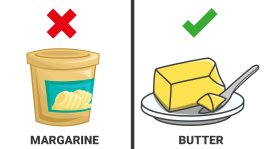Butter and margarine can be added to many people’s everyday breakfast. They just give the perfect taste to toasts, sandwiches, pasta or other foods. According to health experts, many people think that butter and margarine are the same and bring the same results in the body. But in fact there are some differences between these […]

Butter and margarine can be added to many people’s everyday breakfast. They just give the perfect taste to toasts, sandwiches, pasta or other foods.
According to health experts, many people think that butter and margarine are the same and bring the same results in the body.
But in fact there are some differences between these two ingredients, that you should actually know.
Which Are 3 Differences Between Butter And Margarine?
1. THE PROCESSING
Butter products undergo separation and churning, a manufacturing process wherein buttercream derived from milk fat is stirred in a giant industrial machine. The product is then pasteurized and aged 24 hours before churning. Afterward, the final product is shaped and placed into packages for shipping.
Margarine undergoes a process called hydrogenation. Hydrogenation is less complicated, chemically converting liquid vegetable oils into solid or semi-solid fats. It’s actually only a few steps away from being plastic…
2. THE INGREDIENTS
Butter products are made from fermented milk or cream, water, and milk proteins. Dairy salt is added to some varieties of butter, though the product is commonly available as salted or unsalted. Margarine doesn’t contain any dairy at all and is instead made up of emulsifiers, salt, and vegetable oils.
In short, butter is a natural product and margarine is not. Margarine is heavily-processed, and butter is not. Which leads us the next point:
3. THE FATS
All butter sold commercially in the United States must be at least 80 percent fat. Butter is, of course, an animal fat – containing higher amounts of saturated fat than margarine. Unlike the fats contained in most margarine, however, those included in butter are mostly of the omega-3 and omega-6 varieties.
Margarine and spreads found in the dairy aisle range from 10 to 90 percent fat, consisting mainly of the polyunsaturated and monounsaturated varieties. Some margarine products may also contain trans fats, which are notoriously bad for health.
.



